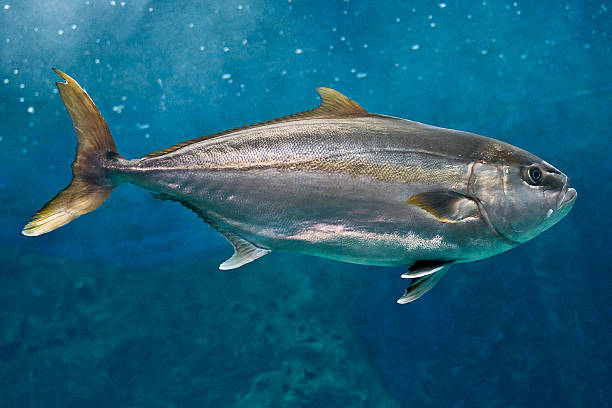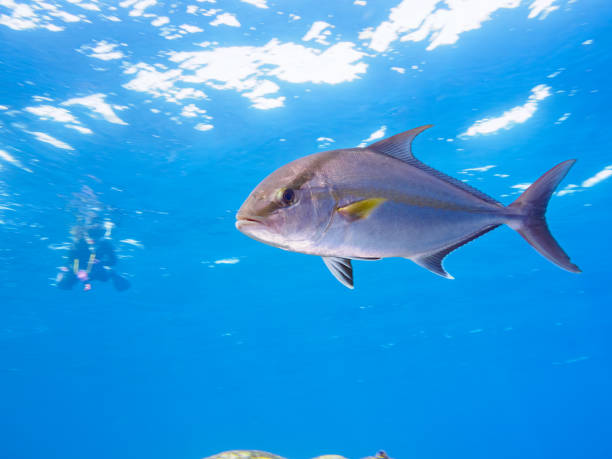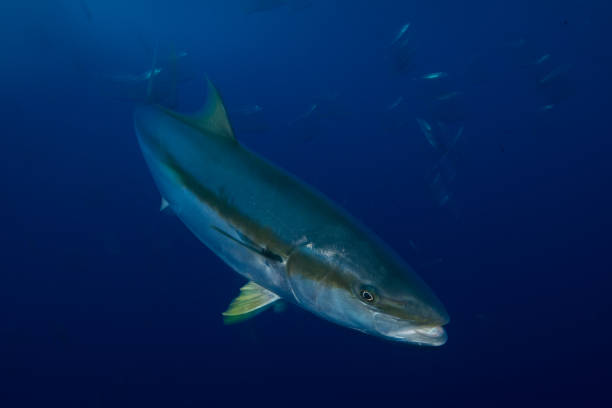Table of Contents
Scientific Classification
| Kingdom | Animalia |
| Phylum | Chordata |
| Class | Actinopterygii |
| Order | Carangiformes |
| Family | Carangidae |
| Genus | Seriola |
| Species | Various species, including Seriola dumerili (Greater Amberjack) and Seriola rivoliana (Almaco Jack) |
| Scientific Name | Seriola spp |
Description
Amberjacks are large, fast-swimming fish celebrated for their strength and agility. They inhabit warm and temperate waters around the globe. The most recognized species include the Greater Amberjack (Seriola dumerili) and the Lesser Amberjack (Seriola fasciata). These fish feature long, streamlined bodies designed for speed, displaying a silvery-blue color with a dark stripe extending from their snout to their dorsal fin.
Amberjacks can grow quite large. Greater Amberjacks can reach lengths of up to 1.8 meters (6 feet) and can weigh over 80 kg (176 lbs). Their robust bodies and keen hunting instincts make them a popular target for sport anglers.

Distribution
Amberjacks inhabit tropical and subtropical oceans worldwide. Their distribution includes:
Atlantic Ocean – Stretching along the U.S. East Coast, Gulf of Mexico, Caribbean, and West Africa.
Pacific Ocean – Ranging from Japan and Australia to the shores of California and South America.
Indian Ocean – Encompassing the waters around India, Madagascar, and the Red Sea.
Typically, they are found in offshore waters and near reefs, showcasing their adaptability to various environments.
Habitat
Amberjacks are typically found in warm, open waters, and their habitats include:
Juvenile amberjacks often congregate near reefs and wrecks, seeking refuge around shipwrecks, reefs, and floating debris to evade predators.
Open Ocean – Adult amberjacks usually inhabit deeper waters but often venture closer to shore while hunting.
Continental Shelves – These regions have depths ranging from 10 to 360 meters (30 to 1,200 feet), depending on the age and species of the amberjack.
Their ability to adapt allows them to thrive in various marine environments, establishing them as top predators in many ecosystems.

Diet
Amberjacks are opportunistic carnivores that primarily feed on:
Small Fish – This includes species like mackerel, herring, and sardines.
Squid and Cuttlefish – These make up a significant portion of their diet, particularly for larger individuals.
Crustaceans – Juvenile amberjacks often consume shrimp and crabs.
As active hunters, amberjacks rely on their speed and keen eyesight to ambush their prey. They frequently hunt in groups to increase their chances of success.
Behavior
Amberjacks are very active and can be found both alone and in schools.
Juvenile amberjacks often school together to protect themselves from predators.
As they grow, adult amberjacks become more independent but may still gather in loose groups while feeding.
They are well-known for their powerful and swift swimming, making them one of the most challenging fish for anglers to catch.
Amberjacks hunt during the day, relying on their keen eyesight to locate prey.
These fish are also known for their migratory behavior, moving between shallow and deep waters in response to seasonal changes and the availability of food.
Lifespan
Amberjacks have a lifespan of around 15 to 17 years, though this varies by species. Growth rates are quick. Individuals mature in 4 to 5 years.
Reproduction and Lifecycle
Amberjacks reproduce through a process called external fertilization, typically occurring in warm waters during the spring and summer months. Their reproductive cycle consists of several key stages:
Spawning in Open Water – During this phase, amberjacks release their eggs and sperm into the water, where fertilization takes place.
High Egg Production – To enhance the chances of survival, females can produce millions of eggs.
Larval Development – Once the eggs hatch, the larvae drift with ocean currents until they find a suitable place near reefs to settle.
Juvenile Growth – The young amberjacks experience rapid growth, utilizing reefs and shipwrecks for shelter before moving out into open waters.
This reproductive strategy is crucial for the species, as it helps them evade predators and adapt to challenging environmental conditions.

Predators
Adult amberjacks are impressive predators, but they face several threats:
Sharks – Including tiger sharks and bull sharks, which hunt adult amberjacks.
Larger Fish – Such as groupers and barracudas, which prey on the younger ones.
Humans – Amberjacks are extensively fished for both commercial and recreational purposes.
Their speed and agility allow them to evade many dangers. However, overfishing poses a significant risk to their populations.
Adaptations
Amberjacks possess a range of adaptations that aid in their survival:
Streamlined Bodies – These enhance their speed and agility in the water.
Powerful Jaws – They enable amberjacks to crush and consume a wide variety of prey.
Countershading Camouflage – With dark backs and light bellies, they can blend into their surroundings, making them less visible to both predators and prey.
Keen Eyesight – This allows them to spot prey and evade predators, even in deep or murky waters.
These traits make amberjacks formidable predators and strong competitors in the marine food chain.
Conservation Status
Amberjacks have different conservation statuses depending on the species. However, several factors put their populations at risk:
Threats:
Overfishing – Due to their popularity in both commercial and recreational fisheries.
Bycatch – Frequently caught unintentionally in tuna and swordfish fisheries.
Habitat Destruction – Coastal developments and reef degradation affect juvenile survival rates.
Climate Change – Warmer oceans and changing currents affect animal migration and food search.
Conservation Efforts:
Fishing Regulations – Numerous countries implement size limits and seasonal closures to safeguard breeding fish.
Marine Protected Areas (MPAs) – Initiatives aimed at preserving essential habitats contribute to maintaining robust fish populations.
Sustainable Fishing Practices – Promoting responsible fishing techniques helps minimize bycatch and prevent overfishing.
While amberjacks remain abundant, ongoing monitoring is essential. Conservation initiatives are crucial for ensuring their future survival.
Conclusion
Amberjacks are remarkable and strong fish that are essential to marine ecosystems. Their speed, intelligence, and adaptability establish them as some of the ocean’s leading predators. They encounter issues such as overfishing and habitat destruction. Nevertheless, conservation initiatives and sustainable practices can contribute to maintaining their populations. Amberjacks are appreciated by marine biologists, sport fishermen, and seafood enthusiasts alike. They are crucial to the ocean’s biodiversity and evoke admiration in many.



